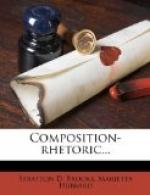EXERCISES
1. Read one of Dickens’s books and bring to class selections that will show how Dickens portrays character by use of action.
2. What kind of man is Silas Marner? What leads you to think as you do?
3. Select three persons from Ivanhoe and state your opinion of their character.
4. Notice the relative importance of plot and character in three magazine stories.
5. Select some person from a magazine story. Tell the class what makes you form the estimate of his character that you do. To what extent does the descriptive matter help you determine his character?
+Theme LXXX.+—Write a character sketch or a story which shows character by means of action.
Suggested subjects:—
1. The girl from Texas.
2. The Chinese cook.
3. Taking care of the baby.
4. Nathan’s temptation.
5. The small boy’s triumph.
6. A village character.
7. The meanest man I ever knew.
(Consider the development of the plot. To what extent have you shown character by action? Can you make the impression of character stronger by adding some description?)
+150. History and Biography.+—Historical and biographical narratives may be highly entertaining and at the same time furnish us with much valuable information. Such writings often contain much that is not pure narration. A historian may set forth merely the program of events, but most histories contain besides a large amount of description and explanation. Frequently, too, all of this is but the basis of either a direct or an implied argument. Likewise a biographer may be chiefly concerned with the acts of a man, but he usually finds that the introduction of description and explanation aids him in making clear the life purpose of the man about whom he writes. In shorter histories and biographies, the expository and descriptive matter often displaces the narrative matter to such an extent that the story ceases to be interesting.




